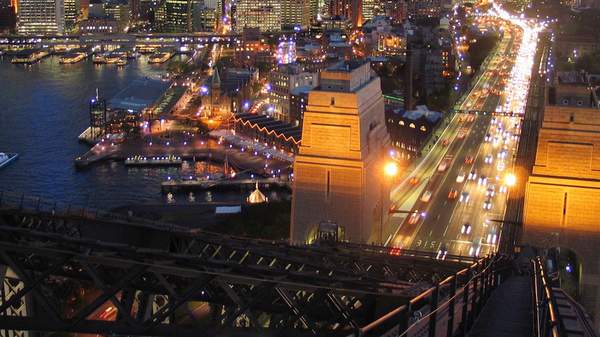Overview
The Coathanger, the Iron Lung, or, simply, the Bridge. However you refer to it, we can all agree that the world’s largest steel arch bridge is not only a powerful monument to humanity’s collective ingenuity but also just a dope addition to an already breathtaking harbour. Add on the fact that hundreds of thousands of vehicles cross its epic span daily and you’re dealing with an object of immense beauty and incredible civic utility.
If you can’t tell by now, we're fans of the Sydney Harbour Bridge. What’s the best aspect of the bridge though? You can climb that motherflippin’ beast! It's one of the most satisfying touristy experiences for a local Sydneysider around — and also one of the best Christmas presents you can get someone who already has everything.
From atop your mighty steel throne you gain some of the best views in the city, if not the world, thanks to the folks at BridgeClimb. So what’s good to peep? Concrete Playground took upon ourselves to find out, so we strapped on our harnesses, passed our compulsory blood alcohol check, and clambered up that mighty arch.
THE MAZE-LIKE STREETS OF THE ROCKS
With all that shimmering, resplendent water to catch your eye, the site of Australia’s first European settlement often gets ignored, but no longer! The Rocks is a labyrinthine warren of dense, intersecting, occasionally superfluous, lanes, alleys and walkways that are still in use today.
A birds eye view of the maze of paths that make up The Rocks is like looking at a living breathing rendering of colonial Sydney. Each cramped stairway and cul-de-sac representing the frenetic energy of the early colonists and their impatience to try to come to grips with this foreign land.
THE POORLY DESIGNED BUT LOVABLE FORT DENISION
This literally used to just be a colossal sandstone rock jutting fifteen metres out of the briny depths. Then Governor Phillip decided that we needed all that sandstone to build ourselves a colony and lo, with the assistance of a bunch of convicts who probably suffered horribly but let’s not think too much about that, Fort Denison was literally hewn from the stone on which it rests. Pinchgut Island, as it came to be known, has had a macabre history as a penal site, a defensive fortress, as well as serving as the burgeoning colony’s preferred site for hanging recalcitrant convicts. While there’s no denying that a lot of blood has been spilled on that islet, the history of Fort Denison is not all doom and gloom.
The centerpiece of the island is the distinctive circular Martello tower, it was the first built in Australia and the last built in the British Empire. This was presumably because poor designs meant that the cannons the tower was built to house were so powerful that their recoil had the potential to undermine the structural integrity of the tower they were in. Never have you seen a more scenic monument to the fine Australian tradition of giving it a red-hot go only to end up half-arseing it because disregarding architectural plans means you are a true-blue, dinky-di ‘Strayan.
THE MIGHTY, MIGHTY HEADS
Sydney Harbour, or Port Jackson for any cartographical purists, is the world’s largest natural harbour. The jewel in the Emerald City’s crown, the entrance to this expansive inlet is flanked by two imposing sandstone promontories, North and South Heads, that shelter us from the wrath of the Tasman Sea. Perched amid the scrub of North Head is the Sydney Quarantine Station, one of the last remaining facilities that were erected in each colony to ward off whooping cough, small pox and other nasty illnesses.
If historical significance and communicable disease prevention is not your bag, don’t fret, the Sydney Harbour National Park has preserved as much of the heads as possible, leaving the undisturbed bush as a potent reminder of the thirty-thousand years of human habitation pre-1788 when the Gadigal people of the Eora nation walked its pristine beaches and byways.
THE OTHER BRIDGE, ANZAC BRIDGE
Often overlooked in favour of the larger and more grandiose eponymous bridge over Sydney harbour, the Anzac Bridge is a stunning example of architectural restraint. From a distance two soaring pylons appear to be trussed by metal gossamer, the sleek steel cables managing to make the bridge appear simultaneously buoyant and grounded.
Formerly known as the Glebe Island Bridge before being renamed in a fit of nationalistic fervour, the Anzac Bridge is a gravity-defying memorial to the contribution of the Australian and New Zealand armed forces and a real pretty sight to boot.
CUSTOMS HOUSE'S LOOMING CLOCK TOWER
The tallest building in Sydney when the Harbour Bridge was built, you’ll recognise Customs House as that building everyone Instagrams when Vivid is on because there’s always some hectic display projected on to it. Located opposite Circular Quay, this iconic landmark is now dwarfed by skyscrapers in every direction, but don’t let that diminish its grandeur.
Once the heart of colonial Sydney this imposing sandstone edifice is a heritage-listed reminder of the overwhelming isolation that early colonists must have felt when maritime trade was the only link to the outside world. On an equally historic but more tragic note, it’s said that the House is built on the spot where the Eora people witnessed the arrival of the First Fleet.
Want to see one of the best views in Sydney for yourself? How about getting your nearest and dearest a climb for Christmas? Head to the BridgeClimb website and book your climb.
Images: BridgeClimb, Dollar Photo Club, Bentley Smith (Flickr CC).
